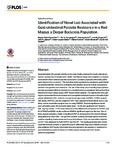Por favor, use este identificador para citar o enlazar este ítem:
http://www.alice.cnptia.embrapa.br/alice/handle/doc/1037157Registro completo de metadatos
| Campo DC | Valor | Lengua/Idioma |
|---|---|---|
| dc.contributor.author | BENAVIDES, M. V. | pt_BR |
| dc.contributor.author | SONSTEGARD, T. S. | pt_BR |
| dc.contributor.author | KEMP, S. | pt_BR |
| dc.contributor.author | MUGAMBI, J. M. | pt_BR |
| dc.contributor.author | GIBSON, J. P. | pt_BR |
| dc.contributor.author | BAKER, R. L. | pt_BR |
| dc.contributor.author | HANOTTE, O. | pt_BR |
| dc.contributor.author | MARSHALL, K. | pt_BR |
| dc.contributor.author | VAN TASSELL, C. | pt_BR |
| dc.date.accessioned | 2016-02-16T11:11:11Z | pt_BR |
| dc.date.available | 2016-02-16T11:11:11Z | pt_BR |
| dc.date.created | 2016-02-16 | pt_BR |
| dc.date.issued | 2015 | pt_BR |
| dc.identifier.citation | Plos One, v. 10, n. 4, e0122797, Apr. 2015. | pt_BR |
| dc.identifier.uri | http://www.alice.cnptia.embrapa.br/alice/handle/doc/1037157 | pt_BR |
| dc.description | Gastrointestinal (GI) parasitic infection is the main health constraint for small ruminant production, causing loss of weight and/or death. Red Maasai sheep have adapted to a tropical environment where extreme parasite exposure is a constant, especially with highly pathogenic Haemonchus contortus. This breed has been reported to be resistant to gastrointestinal parasite infection, hence it is considered an invaluable resource to study associations between host genetics and resistance. The aim of this study was to identify polymorphisms strongly associated with host resistance in a double backcross population derived from Red Maasai and Dorper sheep using a SNP-based GWAS analysis. The animals that were genotyped represented the most resistant and susceptible individuals based on the tails of phenotypic distribution (10% each) for average faecal egg counts (AVFEC). AVFEC, packed cell volume (AVPCV), and live weight (AVLWT) were adjusted for fixed effects and co-variables, and an association analysis was run using EMMAX. Revised significance levels were calculated using 100,000 permutation tests. The top five significant SNP markers with - log10 p-values >3.794 were observed on five different chromosomes for AVFEC, and BLUPPf90/PostGSf90 results confirmed EMMAX significant regions for this trait. One of these regions included a cluster of significant SNP on chromosome (Chr) 6 not in linkage disequilibrium to each other. This genomic location contains annotated genes involved in cytokine signalling, haemostasis and mucus biosynthesis. Only one association detected on Chr 7 was significant for both AVPCV and AVLWT. The results generated here reveal candidate immune variants for genes involved in differential response to infection and provide additional SNP marker information that has potential to aid selection of resistance to gastrointestinal parasites in sheep of a similar genetic background to the double backcross population. | pt_BR |
| dc.language.iso | eng | eng |
| dc.rights | openAccess | eng |
| dc.title | Identification of novel loci associated with gastrointestinal parasite resistance in a Red Maasai x Dorper backcross population. | pt_BR |
| dc.type | Artigo de periódico | pt_BR |
| dc.date.updated | 2016-02-16T11:11:11Z | pt_BR |
| dc.subject.thesagro | Ovelha | pt_BR |
| dc.subject.thesagro | Nematoide | pt_BR |
| dc.subject.thesagro | Doença animal | pt_BR |
| dc.subject.thesagro | Haemonchus Contortus | pt_BR |
| dc.subject.nalthesaurus | Sheep | pt_BR |
| dc.subject.nalthesaurus | Digestive system diseases | pt_BR |
| riaa.ainfo.id | 1037157 | pt_BR |
| riaa.ainfo.lastupdate | 2016-02-16 | pt_BR |
| dc.identifier.doi | 10.1371/journal.pone.0122797 | pt_BR |
| dc.contributor.institution | MAGDA VIEIRA BENAVIDES, CNPASA; TAD S. SONSTEGARD, USDA; STEPHEN KEMP, ILRI; JOHN M. MUGAMBI, KENYA AGRICULTURAL RESEARCH INSTITUTE; JOHN P. GIBSON, UNIVERSITY OF NEW ENGLAND; ROBERT LEYDEN BAKER, WAIKATO, NEW ZEALAND; OLIVIER HANOTTE, UNIVERSITY OF NOTTINGHAM; KAREN MARSHALL, ILRI; CURTIS VAN TASSELL, USDA. | pt_BR |
| Aparece en las colecciones: | Artigo em periódico indexado (CNPASA)  | |
Ficheros en este ítem:
| Fichero | Descripción | Tamaño | Formato | |
|---|---|---|---|---|
| CNPASAmvb.pdf | 3.55 MB | Adobe PDF |  Visualizar/Abrir |









